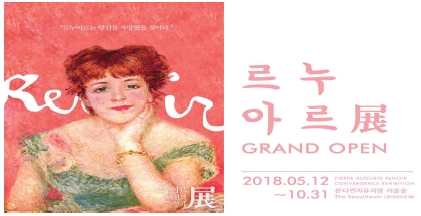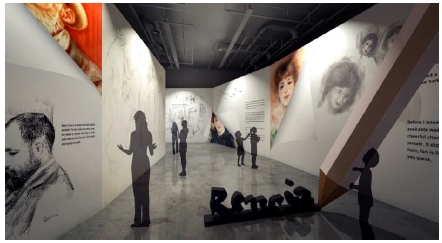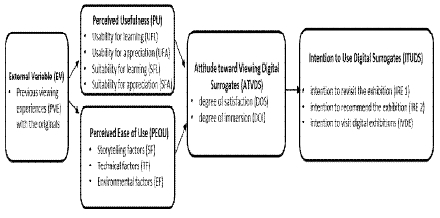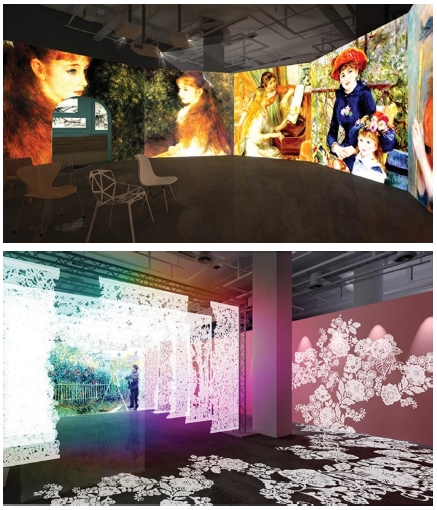
An Empirical Analysis on the Experience of Visitors in Digitally Mediated Exhibition Environment
Copyright ⓒ 2018 The Digital Contents Society
This is an Open Access article distributed under the terms of the Creative Commons Attribution Non-CommercialLicense(http://creativecommons.org/licenses/by-nc/3.0/) which permits unrestricted non-commercial use, distribution, and reproduction in any medium, provided the original work is properly cited.

Abstract
This study empirically investigates the meaning of the digitally remediated experience in <Renoir, Scent of a Woman (2018)> as a form of digital surrogate, based on Technology Acceptance Model (TAM). Our findings show that DOS has a significant correlation with DOI, ITUDS, and detail factors of PU and PEOU. The study proves not only the suitability for TAM as an evaluation model for digital surrogates for remediating the originals but also the feasibility of TAM predicting users' technology acceptance in digitally remediated environment. While requiring further research, the study shows significant proofs of digital surrogate as suitable art appreciation medium which generates auratic experience and a sense of immersion, leaping its former value as a foster-learning tool.
초록
본 연구는 디지털 재생산에 해당하는 <르느와르, 여인의 향기(2018)>를 연구대상으로 기술수용모델(TAM)을 기반으로 디지털 전시환경에서의 경험의 의미와 가치를 도출하는데 목적을 두었다. 상관분석 결과에 의하면, 전시만족도(DOS)는 전시몰입도(DOI) 뿐만 아니라 행동적 이용의사, 인지된 유용성(PU), 인지된 이용용이성(PEOU)과 유의미한 상관관계를 가졌다. 본 연구는 예술작품의 원작을 재매개한 디지털 재생산에 대한 평가 모델로써의 기술수용모델(TAM)의 적절성과 디지털 전시 환경에서 사용자의 기술수용을 예측하는 기술수용모델(TAM)의 타당성을 입증했다. 향후 심도 있는 연구가 요구되지만, 이 연구는 원작을 테크놀로지로 재매개한 디지털 전시가 전통적인 예술작품의 전시와 유사한 경험, 몰입감 등을 발생시킴으로써 감상도구 및 학습적 도구로써의 잠재력을 조명했다는데 그 의의를 두고 있다.
Keywords:
Digital surrogate, Technology Acceptance Model (TAM), Perceived Usefulness (PU), Perceived Ease of Use (PEOU), Degree of Satisfaction (DOS), Degree of Immersion (DOI)키워드:
기술수용모델, 인지된 유용성, 인지된 이용용이성, 전시만족도, 전시몰입도Ⅰ. Introduction
In the age of digital reproductions, data elements can be constantly combined, decombined, and recombined with a fundamental ontological change, eventually generating visual images that form a complete simulation. Through the recombination and manipulation of data, digitized images of paintings introduced a new era for representation. According to Andrew Menard, digitization represents the new world order: the transition from simulacra to simulation and from copying to modeling [1]. Presentation can be varied from the manufacturing of high-quality digital copies of fragile works to create digital exhibits.
Today, digital technology is spawning a variety of new media forms for the purpose of enhancing cultural awareness through visitors' participation and interaction. In particular, cinematic, interactive and technology-driven digital surrogates have recently been widely accessible, and viewers become immersed in digitally remediated environment [2]. For example, Van Gogh Alive (2015), as part of the 2015 Shanghai International Arts Festival's special exhibition, brought to life using over 3,000 images of Van Gogh's most famous artworks. In general, these digital exhibitions generate optical illusion that transforms the fusion between the projected image and real surface into a new object or a large projection screen that appears to be real They also have the potential to create immersive storytelling for exhibitions by heightening interactive engagement and forging deeper cognitive and emotional contextual connections with media. Therefore, the preconceived notions of traditional exhibition visits are foregone in an overwhelmingly invigorating multisensory experience. While progress continues to be made on replicating the physical features of artworks in digital surrogates, many argue that the qualities 3/4 inherent in an artwork become irretrievably lost in the process of technological reproduction [3], referring to Benjamin's concept of aura to claim the superiority of the unmediated artwork experience over the remediated experience via new media technology [4].
Ⅱ. Problem Statement
2-1. Problem Statement and Research Purpose
In this study, the term ‘digital surrogate’ is used to refer to a digital exhibition which is the synthesis of traditional artworks and new media technologies. Digital surrogates of artworks through technological reproduction are nothing new but whereas the reproductions usually serve as a pedagogic purpose either through slide lecture or the aide memoire postcard the reproductions are ‘experienced’ as authentic artworks [5]. There are obviously ‘mixed feelings’ about the quality of digital surrogates and little has been known about of their values in terms of learning and appreciation. Therefore, with a view toward Currie’s notion of the transferability thesis, we contend that there are conditions under which a reproduction of a painting―even a digital image or a media―can generate an authentic experience that is as aesthetically valuable as the experience with the original [6].
The primary concerns voiced by the authors is how viewers perceive the values and qualities embedded in the digital surrogate: Can digitally remediated artworks evoke a sense of authentic experience in terms of art appreciation; and is it possible to move beyond questions of aura to discuss how technically remediated experience of digital surrogate can inspire curiosity and foster learning? This study aims to answer to the problems posed above by analyzing viewer experiences at <Renoir, Scent of a Woman (2018)>, a convergence art exhibition held in Seoul, 2018.
2-2 Research Subject
<Renoir, Scent of a Woman (2018)>, created by BonDaVinch, is filled with various new media, using technologies such as projection mapping, edge blending, interactive sensing, motion graphics, and holograms. Fig. 1. The exhibition consists of six exhibition zonings: Montmarte Garden, Drawing Museum, Media Gallery, Elegant Comfort, Her Silhouette and Renoir’s Atari Fig.2. By projecting high-definition images of Pierre Auguste Renoir’s paintings on the curved, enormous screens, viewers become immersed and move through digital images of masterpieces. Thus, it is almost like watching a mini-film as a cinematic experience; each scene highlighting on a different style of Renoir’s work.
2-3 Research Methodology
To investigate the overall experience of viewers embedded in <Renoir, Scent of a Woman (2018)>, we conducted a survey and quantitative analysis in May 2018. The survey consists of 20 statements to measure participants’ perceptions on the digital surrogates on a Likert scale from 1 to 5 (where 1 = not agree and 5 = strongly agree) Table I. We had a population of college students categorized as digitally native (n=50). 32.8% participants had previous viewing experiences with the originals of Renoir and more than half of participants (53.1%) had an authentic experience in viewing the originals. In addition, 89.8% participants visited digital exhibitions. The quantitative data was analyzed using Frequency Analysis, Correlation Analysis, and an one-way ANOVA method in SPSS 12.0.1.
We adopt and extend the Technology Acceptance Model (hereafter TAM) [7] in order to gauge participant’s engagements with the digital surrogate using a variety of new media technologies. Perceived Usefulness (hereafter PU) and Perceived Ease of Use (hereafter PEOU) are key variables in TAM and they may affect forming positive attitude towards viewing experiences in the digitally remediated environment [8] Fig. 3.
In this study, PU and PEOU are operationally defined Table II and Table III and their correlations between the Degree of Satisfaction (hereafter DOS) and the Degree of Immersion (hereafter DOI) are derived. PU is measured with variables of Usability for Learning (hereafter UFL) and Usability for Appreciation (hereafter UFA) with factors, on the other hand, the influence of three factors, including storytelling factors (SFs), technical factors (TFs) and environmental factors (EFs) on PEOU, is analyzed (Fig. 3). In terms of PEOU, based on the research of immersion factors in exhibitions [9] [10], storytelling factor (SF), technical factor and environmental factor (EF) have derived and those factors were measured in Likert scale.
We set up five hypotheses based on the research model to examine the overall evaluation of viewers’ experiences in the digitally remediated environment. In order to illuminate viewers’ perception of the values and qualities embedded in the digital surrogate, we focus on the relationship between PU and DOS and DOI as well as the relationship between PEOU and DOS and DOI Table IV.
Ⅲ. Results and Findings
3-1. The Experiential Property of the Exhibition
We adopted the notion of the realms of experience into the questionnaire and asked participants to define their experiences in the digital surrogates [11]. According to frequency analysis data, entertainment value (38.4%) was the most compelling value of the participants’ experience in the digital exhibition Table V. In other words, participants took pleasure in encountering the unforeseen digital media. This hedonic value of the exhibition stimulated participants’ power of imagination and enjoyment (33.3%) and immersive experience (49.1%). Unlike other digital exhibitions, including <Monet’s Impression Exhibition (2016)>, <Van Gogh Inside (2015-2016)>, <Hello Michelangelo (2016-2017)> and <Klimpt Inside (2017)>, the deviation of educational value and esthetic value was not relatively large in <Renoir, Scent of a Woman (2018)>. In the case of the preference for exhibition zoning, the preference for Elegant Comfort, Her Silhouette and Montmarte Garden was relatively higher than other zonings Table VI. In addition, Her Silhouette (22.4%), Media Gallery (22.4%) and Elegant Comfort (20.4%) provided immersive experiences for participants.
3-2. DOS and DOI in the Exhibition
The degree of satisfaction with <Renoir, Scent of a Woman (2018)> turned out to be positive (63.8%). In addition, high DOS influenced IRE1 (52.6%), IRE2 (61.4%) and IVDE (55.4%). Among three factors of satisfaction, SF was prominent comparing to other two factors. For detailed factors of DOS, dynamic elements in motion graphics (39.7%) and new interpretation and approaches to the originals (34.5%) in SF, motions graphic effects (34.5%) and interactivity (29.3%) received positive feedbacks in TF have been highly rated. In the case of EF, big-sized screens (22.4%) and background music (15.5%) were highly evaluated Table VI.
The degree of immersion in the exhibition turned out to be positive (65.6%). Unlike the DOS, the influence of TF was the most dominant among the three factors of immersion Table VII. However, just like DOS, dynamic elements in motion graphics (41.4%) in SF, motions graphic effects (34.5%) and big-sized screens (22.4%) had the biggest impact on each immersion factor.
3-3. Comparison of UFL to UFA
Participants highly valued the factors of UFL than those of UFA Table VIII. This result is consistent with the result of the experiential property of the exhibition. In this study, we also explore the relevance between pictorial sameness and aesthetic sameness by comparing of the ratios of SFL and SFA. The ratios of the SFL are higher than those of SFA and there was very little deviations between two ratios. This result was commonly found in the previous researches about digital surrogates.
In terms of relations between UFL and SFL, and UFA and SFA, three factors of UFL are significantly correlated with the SFL (p < .01), and three factors of UFA have correlations with the SFA (p < .01) Table IX. In order to verify the correlation between the previous viewing experiences and SFL and SFA, we implement the standard derivation. As a consequence, the standard derivation value of SFL (3.92) was higher than that of SFA (3.60). Thus, the previous viewing experiences with the originals much influence on SFL rather than SFA.
3-4. The correlation between DOS and DOI, and the correlation between DOS and ITUDS
In this study, the correlation between DOS and DOI, and the correlation between DOS and ITUDS were proved. Our findings show that the DOS not only had a significant correlation with DOI (r = .748**, p < .01), but also influences on the ITUDS Table X. DOS was also relevant to viewing time (r = .353*, p < .05). Both the suitability of motion graphic effect (r=.571**, p < .01) and the suitability of new media technology used in the exhibition (r=.563**, p < .01) had correlations with DOS. Interestingly, the previous viewing experiences with Renoir’s originals were irrelevant to DOS.
3-5. The correlation between PU and DOS and the correlation between PU and DOI
Based on the data of correlation analysis, both DOS and DOI were influenced by the detail factors of UFL and those of UFA. In addition, three factors in both UFL and UFA in PU are correlated with DOS and DOI Table VIII. This result implies as the value of UFL and UFA increase, DOS and DOI also escalate in the digital surrogate.
3-6. The correlation between detail factors of PEOU and DOS and the correlation between detail factors of PEOU and DOI
Based on the result of the correlation analysis, all detail factors of PEOU has a significant correlation with DOS and DOI at the same significance level (** p < .01). Table IX. In previous research, only a few detailed factors of PEOU have an influence on DOS and DOI and none of EF detail factors has a correlation with DOS and DOI. Most notably, we discover that detail factors of SF, TF and EF can have a positive impact on the increase in satisfaction and immersion in the digital surrogate.
Ⅳ. Conclusions and implications
When new media acts as a surrogate for real objects, these developments raise new questions concerning quality of experiences and meanings of those experiences in a digitally remediated environment. The main concern behind mistrusting the use of digital technologies is whether the means can become an end in itself. The growing fascination with digital technology can make the real content look secondary in comparison, and the lost aura may be regained in a way that may lead to the emergence of a new cultural phenomenon―the so-called digital aura
In the evaluation of viewing experiences of the participants in <Renoir, Scent of a Woman (2018)>, our findings show that the DOS has a significant correlation with DOI and ITUDS. The previous viewing experiences with Renoir’s originals did not have any correlation with DOS and DOI, however, they much influenced on SFL rather than SFA. In terms of PU, both the detail factors of UFL and those of UFA positively influenced on DOS and DOI. All detail factors of PEOU also have significant correlations with DOS and DOI. Therefore, detail factors of SF, TF and EF can have a positive impact on the increase in satisfaction and immersion in the digital surrogate.
To sum up, the digital surrogate composed of digitally remediated artwork provides participants with auratic experience. It evokes a feeling of authentic experience, augments a sense of immersion, and stimulates intrinsic motivation for learning as well as appreciation. However, authenticity and aura cannot fully migrate from the original; rather, they can be mitigated in its digital reproduction, according to the comparison of UFL and UFA. In this context, digital reproduction can be characterized as “digital reflections” of physical entities [14] that do not exist per se, but which act complementarily to become an extension of artwork in the walled museums. In order for digital surrogate to generate meaning as a form of exhibition with digital technology, curators and exhibition developers need to carefully consider the detail factors of PU and PEOU at the beginning of exhibition planning.
In this study, we are faced with two interesting phenomena. On one hand, the participants became immersed in the digital reproductions and responded to the artworks in a fashion that resembled how they would react if encountering the original. This phenomenon is labeled as ‘facsimile accommodation’ [15]. On the other hand, a small portion of participants (n = 16) who had previous viewing experiences with Renoir’s originals recalled ‘the memory of the aura’ [16]. However, this study shows that participants’ previous viewing experiences with the originals did not correlate with perceptions of digital aura in the exhibition. In conclusion, this study proves that the aura of an original object can travel and indeed migrate to its digital reproduction. The aura is not destroyed; rather, it is transformed into an immersive environment with hedonic value. Digital reproductions are clearly different from physical works, and these digital representations may add to or change the aura of an original. As a consequence, a digital surrogate as a reproduction of a painting can be as aesthetically valuable as the original [17]. The value of digitally recombined artworks depends on the extent of openness for manipulation and the sophistication of using technologies in the age of digital recombination.
References
- M. Lovejoy, “Digital currents: art in the electronic age”, NY, Routledge, p206-209, (2004).
- B. Rhee, and J.S. Kim, “Mediation between the digital surrogates and viewers based on the technology acceptance model”, Journal of Theoretical and Applied Information Technology, 96(6), p1688-1679, March), (2018.
- W. Schweibenz, “Museum Exhibitions-The Real and the Virtual Ones: An Account of a Complex Relation”, Uncommon Culture, 3(5/6), p38-52, (2013).
- P. Meecham, and E. Stylianou, “Interactive Technologies in the Art Museum”, Designs for Learning, 5(1-2), p94-129, (2014).
- B. L. Taylor, “The Effect of Surrogation on Viewer Response to Expressional Qualities in Works of Art: Preliminary Findings from the Toledo Picture Study”, Museums and the Web 2001: Proceedings p1-29, (2001).
- G. Currie, “The authentic and the aesthetic”, American Philosophical Quarterly, p153-160, (1985).
-
F. D. Davis, “Perceived usefulness, perceived ease of use, and user acceptance of information technology”, MIS quarterly, p319-340, (1989).
[https://doi.org/10.2307/249008]

- S. Y. Hung, C. C. Chen, H. M. Hung, and W. W. Ho, “Critical factors predicting the acceptance of digital museums: User and system perspectives”, Journal of Electronic Commerce Research, 14(3), p231-243, (2013).
- M. B. Stogner, “The Media-Enhanced Museum Experience: Debating the use of media technology in cultural exhibitions, Curator: The Museum Journal, 52(4), p385-397, (2013).
-
M.B. Stogner, “The Immersive Cultural Museum Experience–Creating Context and Story with New Media Technology”, International Journal of the Inclusive Museum, 3(3), (2011), p117-130.
[https://doi.org/10.18848/1835-2014/cgp/v03i03/44339]

- B. J. Pine, and J. H. Gilmore, “The experience economy”, Harvard Business Review, 76(6), p97-105, (1988).
- Krösbacher, C., and Ruddy, J., ‘Authenticity and the Use of Multimedia in Cultural Tourist Attractions–A Contradiction’, Weiermaier, K. /, Brunner-Sperdin, A. (Hg.), Erlebnisinszenierung im Tourismus. Erfolgreich mit emotionalen Produkten und Dienstleistungen, Berlin, Erich Schmidt Verlag, p195-210, (2006).
- Hazen, S., ‘The virtual aura-Is there space for enchantment in a technological world?’, in conference: Museums and the Web 2001, Pittsburgh, Archives & Museum Informatics, (Retrieved March 1, 2005) Available online at: 2001.
- http://E:\MW2001\papers\hazan\hazan.html
-
Styliani, S., Fotis, L., Kostas, K., and Petros, P., ‘Virtual museums, a survey and some issues for consideration’, Journal of cultural Heritage, 10(4), p520-528, (2009).
[https://doi.org/10.1016/j.culher.2009.03.003]

-
P.J. Locher, J.K. Smith, and L.F. Smith, “The influence of presentation format and viewer training in the visual arts on the perception of pictorial and aesthetic qualities of paintings”, PERCEPTION-LONDON-, 30(4), p449-466, (2011).
[https://doi.org/10.1068/p3008]

-
J. D. Bolter, B. MacIntyre, M. Gandy, and P. Schweitzer, New media and the permanent crisis of aura, Convergence: The International Journal of Research into New Media Technologies, 12(1), p21-39, (2011).
[https://doi.org/10.1177/1354856506061550]

- Currie, G., ‘The authentic and the aesthetic’, American Philosophical Quarterly, p153-160, (1985).
저자소개

1987. B.A. Library science, Sungkyunkwan University
1990. M.A. Art, Graduate School of Sungkyunkwan University,
1997. Ph. D. Museum Management, Florida State University
2018. Dept of Art & Technology, Sogang University. / Professor
Now: Collage of Art & Technology, Chung-Ang University / Professor
※ Research Area : user experience in digital exhibition,, museum & art VR & AR, big data and visualization

1998. B.A. Advertising Design, HongIk University
2008. M.F.A. Mutimedia, Ewha Womans University
2018. Ph.D. Film and Media Arts, Sogang University
Now : Dong-Ah Institute of Media and Arts / Professor
※ Research Area:digital exhibition, digital editing, media art




